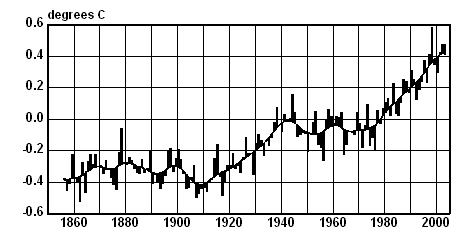Tiempo Climate Cyberlibrary
Global Temperature 2003
- Tiempo archive
- Complete issues
- Selected articles
- Cartoons
- Climate treaty
- Latest news
- Secretariat
- National reports
- IPCC
About the Cyberlibrary
The Tiempo Climate Cyberlibrary was developed by Mick Kelly and Sarah Granich on behalf of the Stockholm Environment Institute and the International Institute for Environment and Development, with sponsorship from the Swedish International Development Cooperation Agency.
While every effort is made to ensure that information on this site, and on other sites that are referenced here, is accurate, no liability for loss or damage resulting from use of this information can be accepted.
|
2003 was the third warmest year in the global surface air temperature record, which extends back to 1856. Newswatch editor Mick Kelly reports. |
|
|
© Tiempo |
|
Global surface air temperature: annual values as departures from the 1961-90 mean and smoothed curve |
|
"The world has experienced another warm year with the four warmest years occurring since 1997," reported Phil Jones, of the Climatic Research Unit at the University of East Anglia in the United Kingdom.
"The summer over much of central Europe was the warmest ever recorded, not just in the instrumental record which goes back to 1781, but also in documentary-based extensions that go back to 1500," he continued.
Almost the whole world was warmer than the 1961-90 baseline during 2003. The warmth was particularly marked around the North Atlantic sector and the Indian Ocean.
The only substantial land area where temperatures were below the recent normal was eastern North America. Parts of the temperate North Pacific Ocean, the subtropical Pacific Ocean off South America and the Southern Ocean were also colder than normal.
Other noteworthy characteristics of the climate of 2003 have been defined in the review "State of the Climate 2003" (edited by David Levinson and Anne Waple) in the June 2004 issue of the Bulletin of the American Meteorological Society:
- the global land surface precipitation average has now fallen below the long-term average for three years in a row;
- drought continued in parts of the Greater Horn and southern Africa but the Sahel rains returned to normal;
- a moderate El Niño event dissipated during the first half of 2003;
- tropical storm activity was below average in the eastern North Pacific; and,
- snow cover in the Northern Hemisphere reached a record low in July 2003;
Carbon dioxide levels rose by about 3 ppm (parts per million) in 2003 at the Mauna Loa Observatory in Hawaii, resulting in a final level of 379 ppm.
Further information
The global surface air temperature record is available for
download.
Links to current climate monitoring information can be
found in
Tiempo Climate Newswatch.
On the Web
The World Meteorological Organization has issued a Statement on the
Status of Global Climate in 2003.
Bright Ideas

General Electric plans to cut solar installation costs by half

Project 90 by 2030 supports South African school children and managers reduce their carbon footprint through its Club programme

Bath & North East Somerset Council in the United Kingdom has installed smart LED carriageway lighting that automatically adjusts to light and traffic levels

The United States National Oceanic and Atmospheric Administration and the American Public Gardens Association are mounting an educational exhibit at Longwood Gardens showing the link between temperature and planting zones

The energy-efficient Crowne Plaza Copenhagen Towers hotel is powered by renewable and sustainable sources, including integrated solar photovoltaics and guest-powered bicycles
El Hierro, one of the Canary Islands, plans to generate 80 per cent of its energy from renewable sources

The green roof on the Remarkables Primary School in New Zealand reduces stormwater runoff, provides insulation and doubles as an outdoor classroom

The Weather Info for All project aims to roll out up to five thousand automatic weather observation stations throughout Africa

SolSource turns its own waste heat into electricity or stores it in thermal fabrics, harnessing the sun's energy for cooking and electricity for low-income families

The Wave House uses vegetation for its architectural and environmental qualities, and especially in terms of thermal insulation

The Mbale compost-processing plant in Uganda produces cheaper fertilizer and reduces greenhouse gas emissions

At Casa Grande, Frito-Lay has reduced energy consumption by nearly a fifth since 2006 by, amongst other things, installing a heat recovery system to preheat cooking oil
Updated: May 15th 2015
